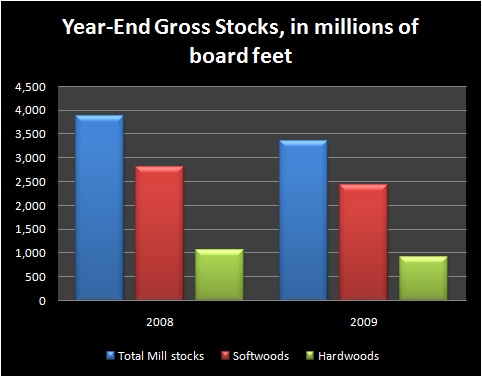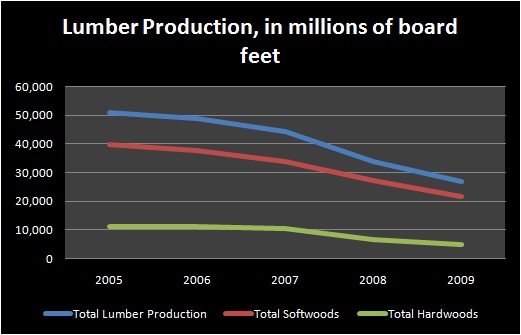traderkenny
Active member
- Messages
- 106
- Likes
- 4
Contract Size: 110,000 board feet (~260 cubic meters)
Price Quote & Tick Size: US Dollars per 1,000 board feet (mbf); minimum tick size is $.10 per mbf ($11 per contract)
Contract Months: Jan, Mar, May, Jul, Sep, Nov
Trading Specs: Open outcry trading is conducted MON-FRI: 9:00 a.m. -1:05 p.m. CT. Electronic trading is conducted via the CME Globex� trading platform MON - THU 5:00pm - 4:00pm CT (next day); SUN and holidays 5:00pm - 4:00pm CT (next day)
Daily Price Limit: $10 per mbf above or below previous day's settlement price; expandable to $15 per mbf
Trading Symbols: LB

Past performance is not indicative of future results.
***chart courtesy of Gecko Software
The following map shows the softwood lumber resources across Canada and the United States:

Concerns over sustainability of lumber resources were brought to industry attention as early as the 1870s and eventually gave rise to professional forestry and the national forest system. Tree nurseries and reforestation efforts are now important parts of the industry.
According to the CME rule book, deliverable types of lumber are nominal lengths of 2x4's manufactured in the western United States or from British Columbia or Alberta in Canada. A variety of rules exist regarding the specifics of origin and the type of wood allowed. Coniferous species like pine, fir, and spruce provide the bulk of softwood used for lumber as well as cedar and hemlock.
Manufacturers remove much of the moisture content from the green lumber, usually surfaced dry to 20% moisture content. Accepted grades No. 1 and No.2 must also be packaged by banding together and wrapping in poly or paper.
The US Census Bureau's 2007 annual industry report shows production by state as illustrated in the following table:

*- Represents zero. D Withheld. Z Less than 500,000 board feet.
**Data courtesy of the US Census Bureau Lumber Production and Mill Stocks report

**Data courtesy of the US Census Bureau Lumber Production and Mill Stocks report

**Data courtesy of the US Census Bureau Lumber Production and Mill Stocks report
Key terms for the lumber market include:
MBF - an abbreviation for 1,000 board feet of lumber (not one million) which is about 83.33 cubic feet or 2.36 cubic meters. Board feet is a common measurement of lumber volume, 144 cubic inches. Lumber is normally specified in its rough size before drying, which is why a finished board is normally smaller than the quoted dimensions.
Hardwood & Softwood - ways to describe wood from different trees. In general, softwoods are often from conifers like pine, fir, and spruce. Hardwoods are most likely from deciduous trees like ash, birch, or cherry. The terms are not always based on actual hardness of the wood e.g. balsa is a hardwood but much softer than a softwood like yew.
Trade Concerns: Issues concerning softwood imports, exports, and applicable duties can often bring volatility. Trade discussions or issues between the United States and Canada are often worthy of note.
Industry Reports: The possible demand and usage within construction reports may bring price volatility. The reports of new home sales and new construction from the US Census Bureau are worth noting as well as the production reports from western wood manufacturers.
Weather: Price volatility is also possible during periods surrounding extreme weather events such as hurricanes, tsunamis, and earthquakes as they related to the overall destruction and perceived rebuilding requirements.
_______________________________________________________________________________________Disclaimer: There is a substantial risk of loss in futures trading and it is not suitable for all investors. Losses can exceed your account size and/or margin requirements. Commodities trading can be extremely risky and is not for everyone. Some trading strategies have unlimited risk. Educate yourself on the risks and rewards of such investing prior to trading. Futures Press Inc., the publisher, and/or its affiliates, staff or anyone associated with Futures Press, Inc. or www.learnaboutfutures.com, do not guarantee profits or pre-determined loss points, and are not held monetarily responsible for the trading losses of others (subscribers or otherwise). Past results are by no means indicative of potential future returns. Fundamental factors, seasonal and weather trends, and current events may have already been factored into the markets. Options DO NOT necessarily move lock step with the underlying futures contract. Information provided is compiled by sources believed to be reliable. Futures Press, Inc., and/or its principals, assume no responsibility for any errors or omissions as the information may not be complete or events may have been cancelled or rescheduled. Any copy, reprint, broadcast or distribution of this report of any kind is prohibited without the expressed written consent of Futures Press, Inc.
Price Quote & Tick Size: US Dollars per 1,000 board feet (mbf); minimum tick size is $.10 per mbf ($11 per contract)
Contract Months: Jan, Mar, May, Jul, Sep, Nov
Trading Specs: Open outcry trading is conducted MON-FRI: 9:00 a.m. -1:05 p.m. CT. Electronic trading is conducted via the CME Globex� trading platform MON - THU 5:00pm - 4:00pm CT (next day); SUN and holidays 5:00pm - 4:00pm CT (next day)
Daily Price Limit: $10 per mbf above or below previous day's settlement price; expandable to $15 per mbf
Trading Symbols: LB

Past performance is not indicative of future results.
***chart courtesy of Gecko Software
Lumber Facts
The production of lumber has a rich history in North America and critical economic importance. As the United States grew westward, so did the timber industry and by the twentieth century, New England's white pine, the Western redwood, pine, and fir forests, and the South's pine forests had become important sources of national lumber.The following map shows the softwood lumber resources across Canada and the United States:

Concerns over sustainability of lumber resources were brought to industry attention as early as the 1870s and eventually gave rise to professional forestry and the national forest system. Tree nurseries and reforestation efforts are now important parts of the industry.
According to the CME rule book, deliverable types of lumber are nominal lengths of 2x4's manufactured in the western United States or from British Columbia or Alberta in Canada. A variety of rules exist regarding the specifics of origin and the type of wood allowed. Coniferous species like pine, fir, and spruce provide the bulk of softwood used for lumber as well as cedar and hemlock.
Manufacturers remove much of the moisture content from the green lumber, usually surfaced dry to 20% moisture content. Accepted grades No. 1 and No.2 must also be packaged by banding together and wrapping in poly or paper.
The US Census Bureau's 2007 annual industry report shows production by state as illustrated in the following table:

*- Represents zero. D Withheld. Z Less than 500,000 board feet.
**Data courtesy of the US Census Bureau Lumber Production and Mill Stocks report

**Data courtesy of the US Census Bureau Lumber Production and Mill Stocks report

**Data courtesy of the US Census Bureau Lumber Production and Mill Stocks report
Key terms for the lumber market include:
MBF - an abbreviation for 1,000 board feet of lumber (not one million) which is about 83.33 cubic feet or 2.36 cubic meters. Board feet is a common measurement of lumber volume, 144 cubic inches. Lumber is normally specified in its rough size before drying, which is why a finished board is normally smaller than the quoted dimensions.
Hardwood & Softwood - ways to describe wood from different trees. In general, softwoods are often from conifers like pine, fir, and spruce. Hardwoods are most likely from deciduous trees like ash, birch, or cherry. The terms are not always based on actual hardness of the wood e.g. balsa is a hardwood but much softer than a softwood like yew.
Key Uses
Lumber is primarily destined for structural construction applications.Key Concerns
Environmental Concerns: The impact of the forestry industry as well as logging practices comes under regular scrutiny and can often spark a number of strong arguments.Trade Concerns: Issues concerning softwood imports, exports, and applicable duties can often bring volatility. Trade discussions or issues between the United States and Canada are often worthy of note.
Industry Reports: The possible demand and usage within construction reports may bring price volatility. The reports of new home sales and new construction from the US Census Bureau are worth noting as well as the production reports from western wood manufacturers.
Weather: Price volatility is also possible during periods surrounding extreme weather events such as hurricanes, tsunamis, and earthquakes as they related to the overall destruction and perceived rebuilding requirements.
_______________________________________________________________________________________
